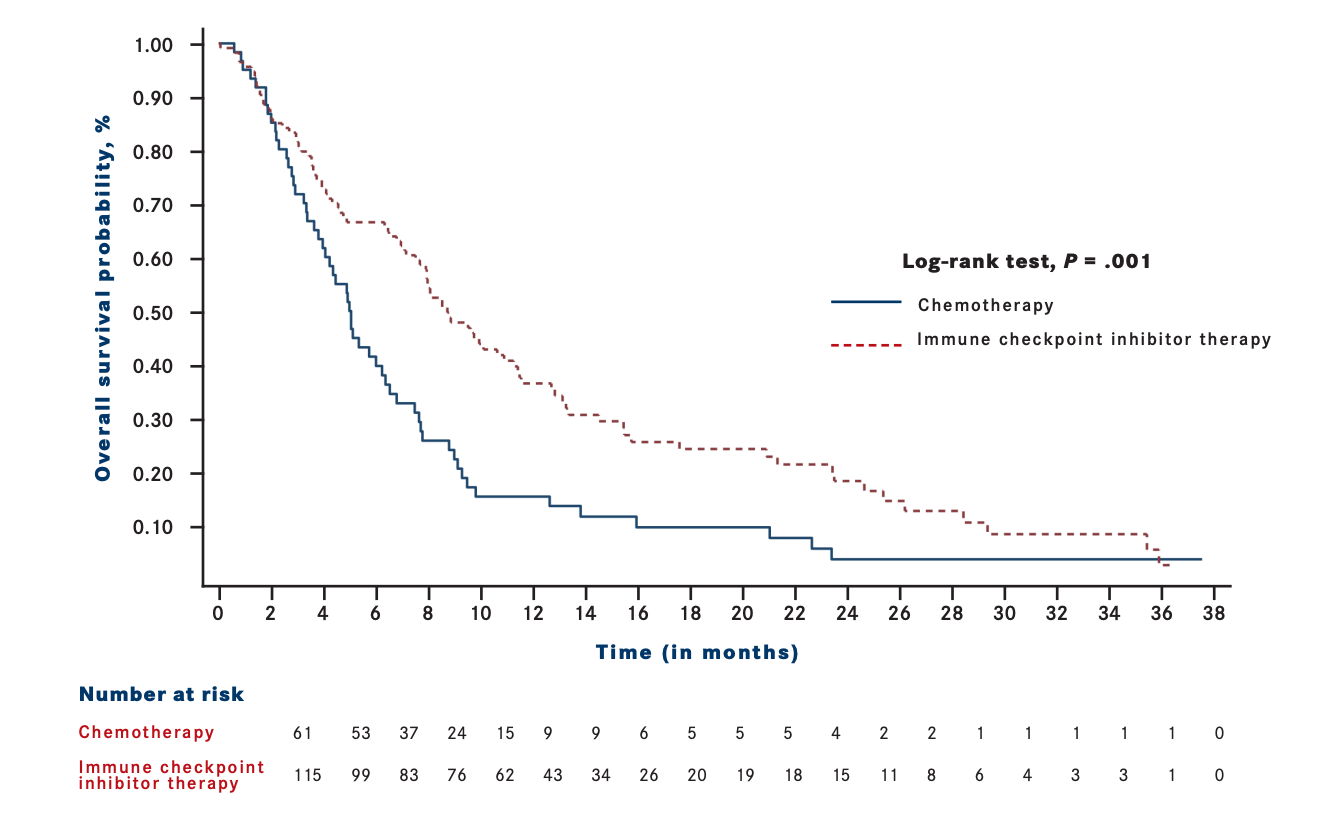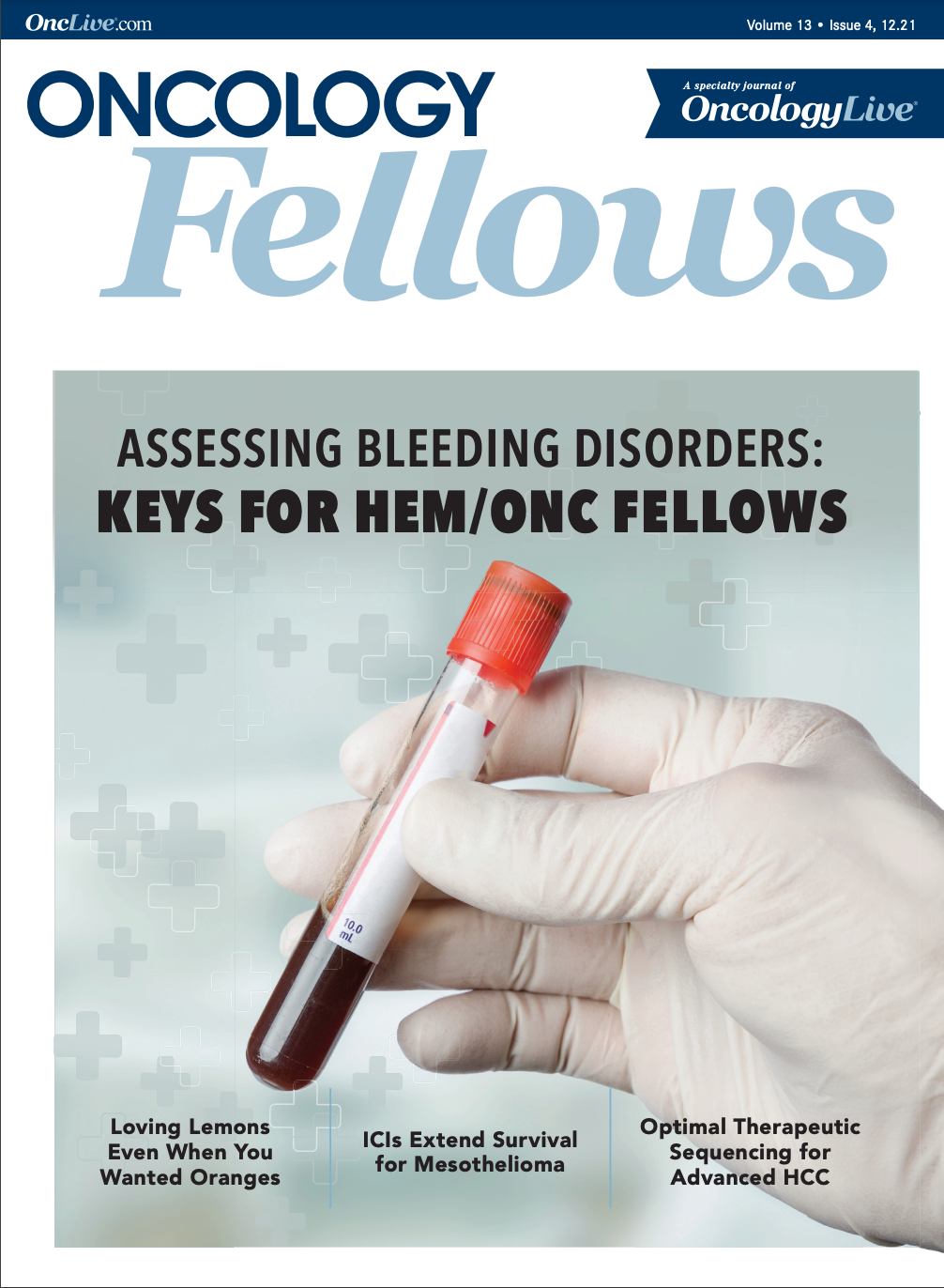Publication
Article
Immune Checkpoint Inhibitors Extend Survival for Mesothelioma
Author(s):
Immune checkpoint inhibitor therapies have ushered in an exciting new phase of clinical research and treatment for malignant pleural mesothelioma.
Roger Y. Kim, MD, MSCE

Immune checkpoint inhibitor (ICI) therapies have ushered in an exciting new phase of clinical research and treatment for malignant pleural mesothelioma (MPM), offering more effective and less toxic treatment options for patients. The research and clinical oncology communities eagerly await the completion of several upcoming trials focused on refining the role of ICIs in the treatment of this rare and deadly disease.
MPM is a rare cancer arising from mesothelial cells that line the pleura.1 In the United States, physicians diagnose approximately 2000 to 3000 new cases per year.2 Most cases have been linked to exposures to mineral fibers, particularly asbestos, and the prognosis is quite poor.3 The median overall survival (OS) is approximately 12 months and varies by histologic subtype.
The epithelioid histologic subtype accounts for an estimated 60% of all MPM diagnoses and portends a slightly more favorable prognosis, with a median OS of 18 months. Conversely, the nonepithelioid (sarcomatoid, biphasic) histologic subtypes are associated with poorer outcomes, with a median OS of 5 to 10 months.4 Among patients with advanced MPM who are not surgical candidates, oncologists frequently offer palliative systemic therapies.5 Since 2004, the pemetrexed/ platinum doublet chemotherapy regimen has been recommended as first-line therapy, and until recently was the only FDA-approved systemic treatment for MPM.6 There has been considerable clinical equipoise regarding recommended regimens for subsequent lines of therapy.
Investigators have recently turned their attention to the immune system’s involvement in mesothelioma pathogenesis. Mesothelioma cancer cells are theorized to be immunogenic because tumor antigens trigger a T-lymphocyte– mediated immune response. This immune response is regulated at 2 critical checkpoints, CTLA-4 and PD-1. Mesothelioma cancer cells have been shown to express PD-L1, which leads to local tumor immunosuppression, allowing malignant cells to evade the immune system.7
Investigators began developing ICIs targeting both CTLA-4 and PD-1 in the early 2010s to block immune system regulation, thereby enhancing the cytotoxic immune response to cancer cells. As a result, we have seen in a paradigm shift in the treatment of several solid malignancies.8,9
Since 2017, National Comprehensive Cancer Network (NCCN) guidelines have recommended the anti–CTLA-4 agent ipilimumab (Yervoy) and the anti-PD-1 agents pembrolizumab (Keytruda) and nivolumab (Opdivo) for subsequent-line use in patients with MPM. This recommendation was based on the promising early results of the KEYNOTE-028 (NCT02054806), INITIATE (NCT03048474), and MAPS2 (NCT02716272) phase 1 and 2 trials.10-12
Notably, although there is overall moderate expression of PD-L1 in MPM tumors, the nonepithelioid histologic subtypes appear to be associated with relatively higher levels of PD-L1 expression compared to the epithelioid subtype. Accordingly, PD-L1 expression has been demonstrated to be associated with worse survival outcomes.13 Moreover, a 2018 observational study by Yannis Metaxas, MD, and colleagues included patients with MPM treated with subsequent-line pembrolizumab and demonstrated similar OS by histologic subtype (median OS, 7.0 [nonepithelioid] vs 6.5 months [epithelioid]), suggesting that ICI may off er increased clinical benefi t to patients with nonepithelioid disease.14
The results of the phase 3 CheckMate743 trial (NCT02899299) comparing fi rst-line nivolumab and ipilimumab with pemetrexed plus carboplatin or cisplatin also suggested a larger eff ect size for ICI associated with nonepithelioid MPM (median OS, 18.1 vs 8.8 months; HR, 0.46; 95% CI, 0.31-0.68) compared with epithelioid MPM (median OS, 18.7 vs 16.5 months; HR, 0.86; 95% CI, 0.69- 1.08). On the strength of the encouraging CheckMate743 results, the FDA approved ICI for first-line MPM treatment in October 2020.
In our manuscript published May 18, 2021, in JTO Clinical and Research Reports, we sought to evaluate the real-world uptake of off-label second-line ICI among patients with MPM who received traditional first-line chemotherapy and assess the association of MPM histologic subtype on ICI uptake before and after the 2017 NCCN MPM guideline revision.15
Our retrospective, multicenter cohort study used deidentified electronic health record data from the Flatiron Health database and included a total of 426 patients with MPM diagnosed between January 2011 and December 2019 who received first-line and second-line systemic therapies recommended by the 2017 NCCN MPM guidelines. In our study cohort, 310 (72.8%) patients had epithelioid and 116 (27.2%) nonepithelioid histologic subtypes (48 sarcomatoid, 68 biphasic).
Compared with patients enrolled in clinical trials, those included in our real-world cohort were notably older (median age, 73 years) and more diverse (19% were nonwhite) and had poorer performance status (11% ECOG 2-4). During the entire study period, 144 patients (33.8%) received second-line ICI and 282 (66.2%) received second-line traditional chemotherapy. ICI uptake began in 2015 and in each subsequent year, an increasing proportion of patients received ICI (P < .001). Beginning the first quarter of 2016, we observed rapid and sustained adoption of second-line ICI, largely driven by pembrolizumab uptake. This was despite ICI not being FDA approved at the time.
After adjusting for patient age, sex, race, ECOG performance status, clinical center volume, and type of insurance, we found that patients with nonepithelioid MPM were more likely to receive second-line ICI after the 2017 NCCN MPM guideline revision (adjusted OR, 3.26; 95% CI, 1.41-7.54).
While we were unable to ascertain the exact reason for this association given the inherent limitations associated with our observational study design, we hypothesized that treating oncologists may have been informed by contemporaneous preliminary evidence of possible increased ICI effi cacy in nonepithelioid compared with epithelioid MPM. Another possibility was that the inherently worse prognoses associated with nonepithelioid MPM prompted clinicians to lower their thresholds for prescribing novel therapies in hopes of deriving therapeutic benefit.
Despite this early enthusiasm for second-line ICI we reported in our study, recent phase 3 studies have not clearly demonstrated superior OS outcomes for subsequent-line ICI compared with chemotherapy. While early results from the CONFIRM trial (NCT03063450) demonstrated improved survival with nivolumab compared with placebo (median OS, 9.2 vs 6.6 months; HR, 0.72), the PROMISE-Meso trial (NCT02991482) did not report any significant improvement in OS for pembrolizumab vs chemotherapy (median OS, 10.7 vs 12.4 months; HR, 1.12).16,17
Thus, in our manuscript recently published in Lung Cancer, our objective was to evaluate the comparative effectiveness of second-line ICI vs chemotherapy on OS outcomes in real-world patients with MPM who received standard first-line chemotherapy.18 We again used the Flatiron Health database to conduct a retrospective cohort study of patients with MPM receiving second-line therapy from 2015 to 2019. This study included 176 patients, 115 (65%) of whom received second-line ICI and 61 (35%) chemotherapy.
Median OS was 8.7 months (95% CI, 7.7-10.9 months) in the ICI group and 5.0 months (95% CI, 4.0-6.4 months) in the chemotherapy group (P = .001). The 12-month estimated OS probability was 36.7% (95% CI, 27.6%-45.8%) in the ICI group compared with 15.6% (95% CI, 7.7%-26.1%) in the chemotherapy group (Figure).18
Figure. Overall Survival of Patients With MPM Receiving Second-Line Therapy18

After adjusting for patient age, sex, race, histologic subtype, ECOG performance status, first-line therapy, time since start of first-line therapy, year of second-line therapy, and prior surgical resection, second-line ICI was associated with improved OS outcomes compared with chemotherapy (adjusted HR, 0.52; 95% CI, 0.34-0.81). Although we did not observe a significant difference by histologic subtype, our study was not powered to adequately evaluate this interaction.
These results suggest possible clinical benefit of second-line ICI over chemotherapy among patients with MPM receiving routine care. However, further research is required to elucidate the role of secondline ICI for MPM treatment, especially with the recent emergence of first-line ICI regimens. Several clinical trials are under way to assess the use of ICI with or without chemotherapy, in the adjuvant and neoadjuvant settings, and with antiangiogenesis therapy, among other clinical contexts.
References
- Kim RY, Sterman DH, Haas AR. Malignant mesothelioma: has anything changed? Semin Respir Crit Care Med. 2019;40(3):347-360. doi:10.1055/s-0039-1693406
- Bray F, Ferlay J, Soerjomataram I, Siegel RL, Torre LA, Jemal A. Global cancer statistics 2018: GLOBOCAN estimates of incidence and mortality worldwide for 36 cancers in 185 countries. CA Cancer J Clin. 2018;68(6):394-424. Published correction appears in CA Cancer J Clin. 2020;70(4):313.
- Carbone M, Kratzke RA, Testa JR. The pathogenesis of mesothelioma. Semin Oncol. 2002;29(1):2-17. doi:10.1053/sonc.2002.30227
- Verma V, Ahern CA, Berlind CG, et al. Survival by histologic subtype of malignant pleural mesothelioma and the impact of surgical resection on overall survival. Clin Lung Cancer. 2018;19(6):e901-e912. doi:10.1016/j. cllc.2018.08.007
- Kindler HL, Ismaila N, Armato SG 3rd, et al. Treatment of malignant pleural mesothelioma: American Society of Clinical Oncology clinical practice guideline. J Clin Oncol. 2018;36(13):1343-1373. doi:10.1200/ JCO.2017.76.6394
- Vogelzang NJ, Rusthoven JJ, Symanowski J, et al. Phase III study of pemetrexed in combination with cisplatin versus cisplatin alone in patients with malignant pleural mesothelioma. J Clin Oncol. 2003;21(14):2636- 2644. doi:10.1200/JCO.2003.11.136
- Scherpereel A, Wallyn F, Albelda SM, Munck C. Novel therapies for malignant pleural mesothelioma. Lancet Oncol. 2018;19(3):e161-e172. doi:10.1016/S1470-2045(18)30100-1
- Weber JS, D'Angelo SP, Minor D, et al. Nivolumab versus chemotherapy in patients with advanced melanoma who progressed after anti-CTLA-4 treatment (CheckMate 037): a randomised, controlled, open-label, phase 3 trial. Lancet Oncol. 2015;16(4):375-384. doi:10.1016/S1470- 2045(15)70076-8
- Brahmer J, Reckamp KL, Baas P, et al. Nivolumab versus docetaxel in advanced squamous-cell non-small-cell lung cancer. N Engl J Med. 2015;373(2):123-135. doi:10.1056/NEJMoa1504627
- Alley EW, Lopez J, Santoro A, et al. Clinical safety and activity of pembrolizumab in patients with malignant pleural mesothelioma (KEYNOTE-028): preliminary results from a non-randomised, open-label, phase 1b trial. Lancet Oncol. 2017;18(5):623-630. doi:10.1016/S1470-2045(17)30169-9
- Disselhorst MJ, Quispel-Janssen J, Lalezari F, et al. Ipilimumab and nivolumab in the treatment of recurrent malignant pleural mesothelioma (INITIATE): results of a prospective, single-arm, phase 2 trial. Lancet Respir Med. 2019;7(3):260-270. doi:10.1016/S2213-2600(18)30420-X
- Scherpereel A, Mazieres J, Greillier L, et al; French Cooperative Thoracic Intergroup. Nivolumab or nivolumab plus ipilimumab in patients with relapsed malignant pleural mesothelioma (IFCT-1501 MAPS2): a multicentre, open-label, randomised, non-comparative, phase 2 trial. Lancet Oncol. 2019;20(2):239-253. Published correction appears in Lancet Oncol. 2019;20(3):e132
- Mansfield AS, Roden AC, Peikert T, et al. B7-H1 expression in malignant pleural mesothelioma is associated with sarcomatoid histology and poor prognosis. J Thorac Oncol. 2014;9(7):1036-1040. doi:10.1097/ JTO.0000000000000177
- Metaxas Y, Rivalland G, Mauti LA, et al. Pembrolizumab as palliative immunotherapy in malignant pleural mesothelioma. J Thorac Oncol. 2018;13(11):1784-1791. doi:10.1016/j.jtho.2018.08.007
- Kim RY, Mitra N, Bagley SJ, et al. Immune checkpoint inhibitor uptake in real-world patients with malignant pleural mesothelioma. JTO Clin Res Rep. 2021;2(6):100188. doi:10.1016/j.jtocrr.2021.100188
- Fennell D, Ottensmeier C, Califano R, et al. Nivolumab versus placebo in relapsed malignant mesothelioma: the CONFIRM phase 3 trial. J Thorac Oncol. 2021;16(suppl 3):S62. doi:10.1016/j.jtho.2021.01.323
- Popat S, Curioni-Fontecedro A, Dafni U, et al. A multicentre randomised phase III trial comparing pembrolizumab versus single-agent chemotherapy for advanced pre-treated malignant pleural mesothelioma: the European Thoracic Oncology Platform (ETOP 9-15) PROMISE-meso trial. Ann Oncol. 2020;31(12):1734-1745. doi:10.1016/j.annonc.2020.09.009
- Kim RY, Li Y, Marmarelis ME, Vachani A. Comparative effectiveness of second-line immune checkpoint inhibitor therapy versus chemotherapy for malignant pleural mesothelioma. Lung Cancer. 2021;159:107-110. doi:10.1016/j.lungcan.2021.06.017







